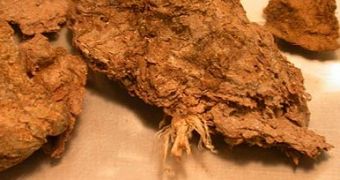All the anthropologic manuals talk about the Clovis people as the first Native Americans. But South American fossils show that the continent was already inhabited by Asian Blacks (the type of the Papuans and Australian Aborigines) by the time Clovis entered North America. And a new research published in the journal "Science" shows, based on DNA extracted from human coprolites (fossilized feces) recovered from Oregon's Paisley Caves (in the eastern Cascade Range), that the oldest known humans in the New World inhabited the continent 14,300 years ago, 1,200 years before Clovis culture. This mitochondrial DNA (transmitted only on the maternal line) also showed links to Siberia or Asia.
The eight caves where the coprolites were found are orientated to the west on the highest shoreline of Lake Chewaucan, whose levels fluctuated during the Pleistocene (before 10,000 years ago).
"The Paisley Cave material represents, to the best of my knowledge, the oldest human DNA obtained from the Americas. Other pre-Clovis sites have been claimed, but no human DNA has been obtained, mostly because no human organic material had been recovered," said Eske Willerslev, director of the Centre for Ancient Genetics at Denmark's University of Copenhagen.
The Danish team led by Willerslev analyzed 14 coprolites collected in 2002 and 2003. The eventual DNA contamination was checked. Radiocarbon dating via accelerator mass spectrometry indicated to 14,300 years ago.
"All six coprolites containing ancient DNA underwent additional testing at two independent labs. Three of the six also contained DNA similar to red fox, coyote or wolf," said Dennis L. Jenkins, a senior archaeologist at the University of Oregon's Museum of Natural and Cultural History, who leads the diggings at the caves. Those animals could have been eaten by the early Americans or they urinated on the coprolites at a later date. The DNA matched with the haplogroups A2 and B2, common in Siberia and East Asia.
The Clovis culture emerged between 13,200 to 12,900 years ago, and the main proofs of its existence are specific fluted Clovis points and other stone tools.
"Exactly who these people living in the Oregon caves were is not known. The Paisley Caves lack lithic tool assemblages, thus the cultural and technological association of the early site occupants, and their relationship to the later Clovis technology are uncertain. At this point, we know they most likely came from Siberia or Eastern Asia, and we know something about what they were eating, which is something we can learn from coprolites," said Jenkins.
"If our DNA evidence and radiocarbon dating hold up on additional coprolites that are now undergoing testing at multiple labs, then we have broken the Clovis sound barrier, if you will. If you are looking for the first people in North America, you are going to have to step back more than 1,000 years beyond Clovis to find them," added Jenkins.
The work at Paisley caves was started by Luther Cressman, dead in 1994, an anthropologist at the University of Oregon, in the 1930s.
In four of the caves, Jenkins's team has found manufactured threads of sinew and plant fibers, hide, basketry, cordage, rope, wooden pegs, animal bones, two forms of projectile point fragments and various kinds of feces, spreading from the late Pleistocene and Holocene (less than 10,000 years ago).
"Some of the thread is narrower than that holding buttons on many shirts today and date back 12,750 years. We found a little pit in the bottom of a cave. It was full of camel, horse and mountain sheep bones, and in there we found a human coprolite. We radiocarbon-dated the camel and mountain sheep bones, as well as the coprolite, to 14,300 years ago," said Jenkins, also director of the Northern Great Basin Archaeological Field School.
This dating places the Oregon site in the same period with Chile's Monte Verde site.
"Cressman was correct about the association of human cultural remains with Pleistocene animals such as the now extinct camels, horses, and bison that once ranged the plain in front of the Paisley Caves, but it has taken nearly 70 years and the development and application of new scientific methods to prove it. Had the human coprolites at the Paisley Caves not been analyzed for DNA and subjected to rigorous dating methodology, the pre-Clovis age of the artifacts recovered with the megafaunal remains could not have been conclusively proven," said Jenkins.

 14 DAY TRIAL //
14 DAY TRIAL //